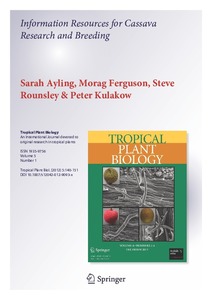| dc.contributor.author | Ayling, S. |
| dc.contributor.author | Ferguson, M. |
| dc.contributor.author | Rounsley, S. |
| dc.contributor.author | Kulakow, P.A. |
| dc.date.accessioned | 2019-12-04T11:04:21Z |
| dc.date.available | 2019-12-04T11:04:21Z |
| dc.date.issued | 2012 |
| dc.identifier.citation | Ayling, S., Ferguson, M., Rounsley, S. & Kulakow, P. (2012). Information resources for cassava research and breeding. Tropical Plant Biology, 5(1), 140-151. |
| dc.identifier.issn | 1935-9756 |
| dc.identifier.uri | https://hdl.handle.net/20.500.12478/1408 |
| dc.description.abstract | Cassava is a globally important food security and industrial crop produced for food, feed, starch and biofuel. Cassava is drought-tolerant and can grow in poor soils. Roots can be stored in the ground for long periods as part of intact growing plants, allowing flexible harvest times for poor farmers in the tropics. In addition, due to cassava’s inherently high starch content, it is a popular source of carbon for industrial purposes and increasingly biofuel. It is, however, relatively low in nutrients and susceptible to several pests and diseases, including attacks from whitefly, mealybug, green mite, cassava mosaic viruses and cassava brown streak viruses. A number of groups worldwide are working to improve cassava by conventional breeding, by molecular marker-aided breeding, and through the use of transgenic approaches. To facilitate the work of these groups, easy access to up-to-date and integrated information resources are essential to enable knowledge sharing and data mining. Here we review the information resources currently available to breeders and researchers and discuss future directions for the cassava community’s data integration and curation. |
| dc.format.extent | 140-151 |
| dc.language.iso | en |
| dc.subject | Manihot Esculenta |
| dc.subject | Databases |
| dc.subject | Agricultural |
| dc.subject | Research |
| dc.subject | Cassava |
| dc.subject | Breeding |
| dc.subject | Genomes |
| dc.title | Information resources for cassava research and breeding |
| dc.type | Journal Article |
| dc.description.version | Peer Review |
| cg.contributor.crp | Roots, Tubers and Bananas |
| cg.contributor.affiliation | Norwich Research Park |
| cg.contributor.affiliation | International Institute of Tropical Agriculture |
| cg.contributor.affiliation | Dow AgroSciences |
| cg.coverage.region | Africa |
| cg.coverage.region | Asia |
| cg.coverage.region | Latin America |
| cg.coverage.region | West And Central Africa |
| cg.coverage.country | Brazil |
| cg.coverage.country | United States |
| cg.coverage.country | China |
| cg.coverage.country | Nigeria |
| cg.isijournal | ISI Journal |
| cg.authorship.types | CGIAR and advanced research institute |
| cg.iitasubject | Cassava |
| cg.iitasubject | Plant Genetic Resources |
| cg.journal | Tropical Plant Biology |
| cg.howpublished | Formally Published |
| cg.accessibilitystatus | Limited Access |
| local.dspaceid | 79549 |
| cg.identifier.doi | https://dx.doi.org/10.1007/s12042-012-9093-x |

